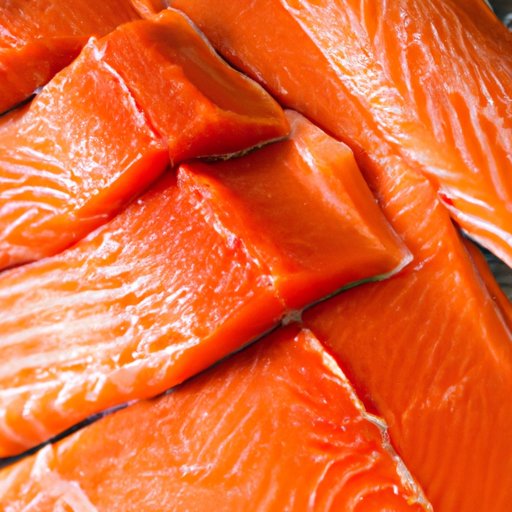
Introduction
Salmon is a popular and delicious seafood that many people enjoy. However, it is important to know how to tell if salmon is bad since eating spoiled fish can cause food poisoning. Spoiled salmon can lead to serious illness that includes vomiting, stomach cramps, and diarrhea, which can last for days.
In this article, we will discuss the sensory indicators of bad salmon, the signs of expiration, education on storage conditions, and tips for proper salmon handling to ensure that you can enjoy your salmon dish safely.
Sensory Indicators of Bad Salmon
There are certain sensory indicators that one can use to tell if the salmon is bad. Use your visual senses, sense of smell, and taste buds to check for spoilage.
Visual Indicators
Bad salmon usually has a different color and texture than fresh salmon. It may have brown spots, an off-white color, or have a dull appearance. Fresh salmon should have a bright, vibrant, and shiny appearance.
Aroma Indicators
Bad salmon has a strong, putrid smell, with an ammonia-like pungent odor. Fresh salmon, on the other hand, smells like the ocean or seaweed.
Taste Indicators
When you taste bad salmon, it will be bitter, sour, or metallic. According to the USDA, bad salmon generally has a slimy texture.
Signs of Expiration
Salmon can go bad when it is kept too long, and there are signs to look out for.
Discoloration
When salmon is expired or goes bad, it turns from a bright and vibrant color to a dull, grayish color. Meat that looks off is a sign that it has gone bad and should not be eaten.
Changes in Texture
Fresh salmon has a firm texture, but bad salmon often feels mushy or slimy. If you press your finger into the flesh, and it doesn’t snap-back, it likely has gone bad.
Shifts in Aroma
Another sign of Salmon expiration is that it gives off a bad smell. This smell gets worse over time, so be vigilant of the smell of fresh salmon when you purchase it. If it starts smelling bad or just different, it could be a sign of spoilage.
Education on Storage Conditions
The storage condition of salmon significantly affects its freshness. Proper storage is essential to avoid spoilage and ensure that it is safe to eat.
Temperature Range for Storage
The temperature range for storing salmon should be between 32 degrees Fahrenheit and 39 degrees Fahrenheit, refrigerated. When you buy fresh salmon, it usually has a shelf life of about two days if kept in a refrigerator at this temperature. Alternatively, if you want to save your salmon for a more extended period, you can freeze it. In this case, the salmon should be kept at 0 degrees Fahrenheit.
Vacuum Sealing
Vacuum sealing is an essential aspect of salmon storage to keep it fresh for longer. In vacuum-sealed packaging, salmon can last up to two weeks while stored at around 32-34 degrees Fahrenheit.
Risk of Contamination
Contamination can occur due to improper handling and storage conditions or from the equipment used to filet the salmon. When handling fresh salmon, always be sure to clean your workspace thoroughly with antibacterial soap to avoid transferring bacteria to the fish. Also, rinse the salmon under cold water and pat dry with a clean cloth to remove any bacteria or juices from the surface.
Inspection Process
Inspecting the salmon to determine if it is still good follows a thorough process to guarantee its freshness and quality.
Guidelines for Inspection
- Examine the visual appearance.
- Smell the salmon before purchase or cooking it.
- Check the texture by pressing your fingers gently on the flesh.
Handling Tips
When handling salmon, it is crucial to wash your hands before and after handling raw fish to avoid contamination. Additionally, use separate cutting boards, knives, and other utensils to keep seafood-specific bacteria from contaminating other foods in the kitchen.
Using Your Senses
Use your senses when inspecting salmon. The color should be light pink to bright orange with iridescent sheen, the texture should be firm, and the smell should be of seaweed or oceanic air.
Tips for Proper Salmon Handling
Taking care of your salmon is fundamental to ensure its freshness and safety while cooking it.
Thawing Procedures
Thawing the salmon correctly is crucial to avoid bacterial growth and contamination. Instead of leaving it on the countertop, thaw it under cold running water or in the refrigerator.
Cooking Temperature
Cook the salmon properly. Baking or cooking it to an internal temperature of 145 degrees Fahrenheit is critical to prevent food poisoning from any remaining bacteria. Use a food thermometer to gauge the temperature of the salmon.
Storing Leftovers
Do not leave leftovers out at room temperature after cooking since this can cause salmonella and other foodborne illnesses. Dry, cooked salmon can be stored in the refrigerator for around three days in an airtight container, and freezing is an option for longer storage.
Conclusion
Consuming spoiled salmon can lead to foodborne illness, which is why it is essential to detect its freshness before cooking and eating it. In addition to the visual and aroma indicators, always try to keep salmon refrigerated or frozen and handle it carefully to prevent contamination. Following the guidelines discussed in this article, you can enjoy a safe and delicious seafood dish.




